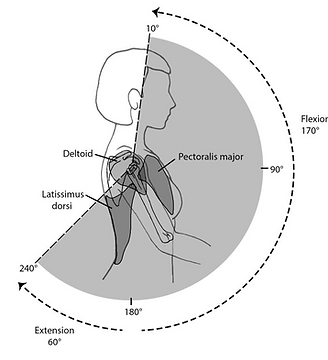
SHOULDER
This chapter will review anatomical systems related to the shoulder. Common considerations for designers and engineers when innovating products for the shoulder will also be reviewed, along with an example student project.
SECTION 1 - ANATOMICAL SYSTEMS
Overview of the skeletal, muscular & nervous systems related to the shoulder.
Anterior
Posterior

Superior
Shoulder Skeletal System
Modified from LaBat & Ryan, Figure 4.17. Skeleton - shoulder area, linking arm to upper body (anterior, posterior & superior views).
Anterior
Posterior
.jpg)
Shoulder Muscular System
Modified from LaBat & Ryan, Figure 4.23. Muscles: Upper torso & limbs (anterior & posterior).
Anterior
Posterior

Shoulder Nervous System - Peripheral Nerves (anterior & posterior)
Modified from LaBat & Ryan, Figure 4.27
SECTION 2 - DESIGN CONSIDERATIONS
When designing products that are worn around the shoulder, it is important to consider how the anatomical systems move.

Shoulder Range of Motion, Flexion/Extension, with Muscles
LaBat & Ryan, Figure 4.37

Shoulder Range of Motion, Abduction/Adduction, with Muscles
LaBat & Ryan, Figure 4.38

Shoulder Range of Motion, Medial/ Lateral Rotation, with Muscles
LaBat & Ryan, Figure 4.39
SECTION 3 - KNOWLEDGE IN PRACTICE
With this information in mind, let's take a look at a product designed for the shoulder.

Design Problem:
Systems Involved:
A ballet leotard designed to support the muscles of the shoulders & lower back, where the promotion of better posture & form actively reduces the risk of spinal injury
Skeletal and muscular systems
Useful Resources:
-
Study of aesthetic needs of ballet dancers
-
Kinesiotape trials of support structures to understand performance
-
Interview with ballet-specific physiotherapist
Follow the link below to learn more about this project.